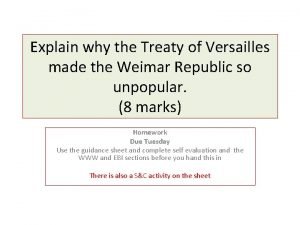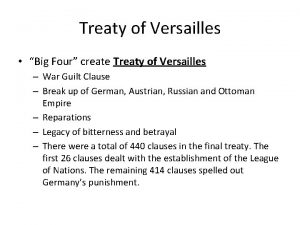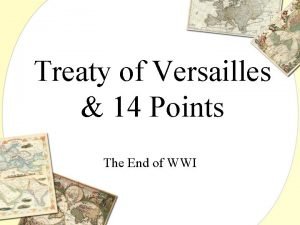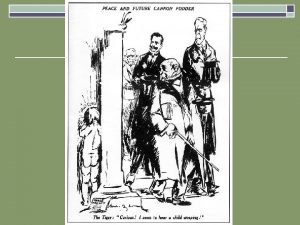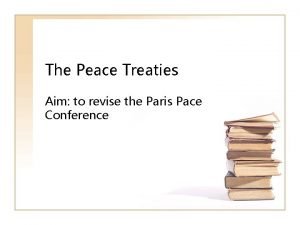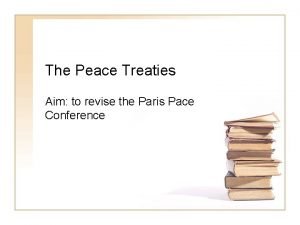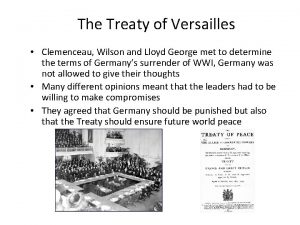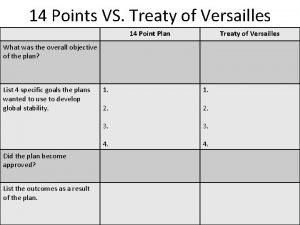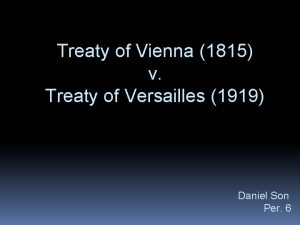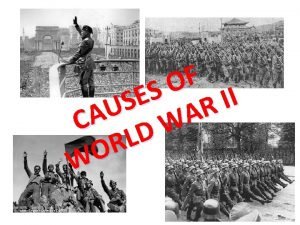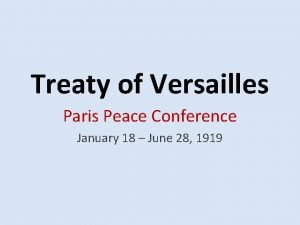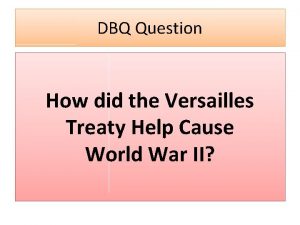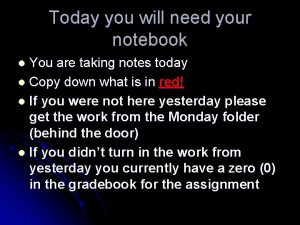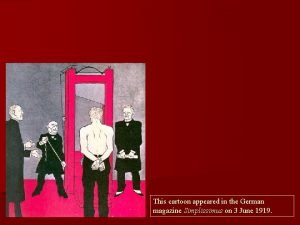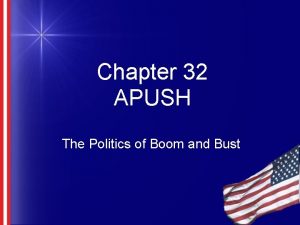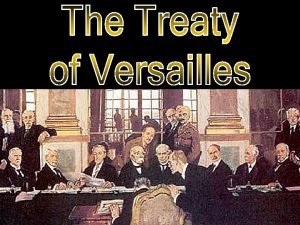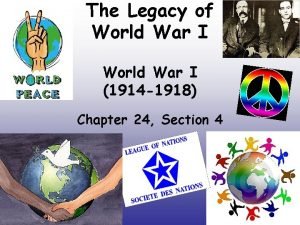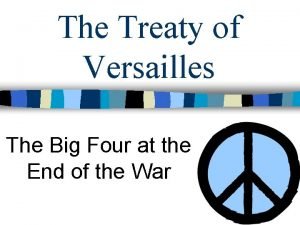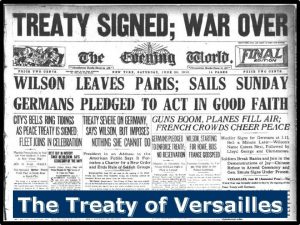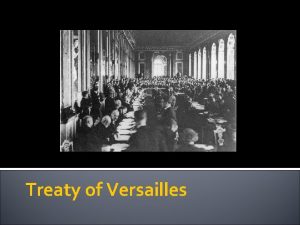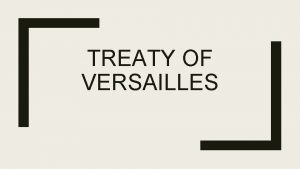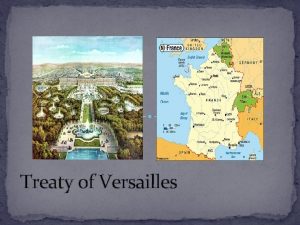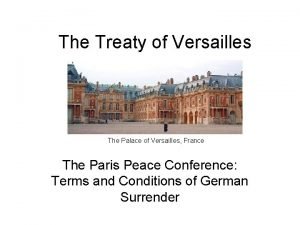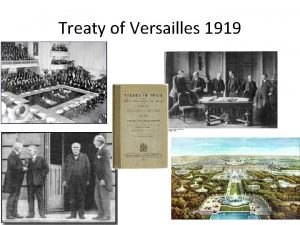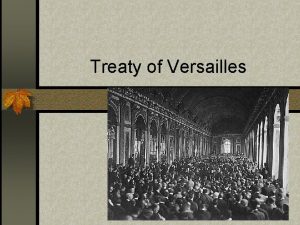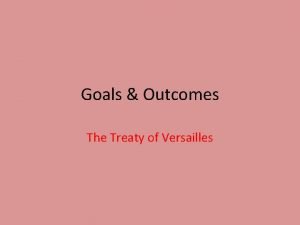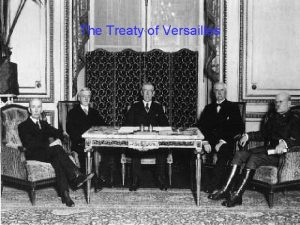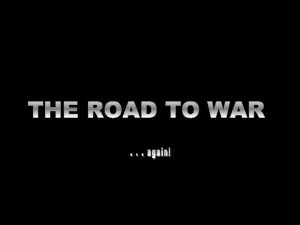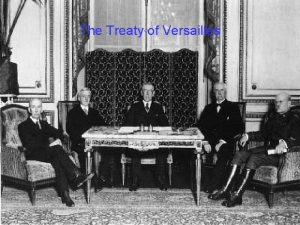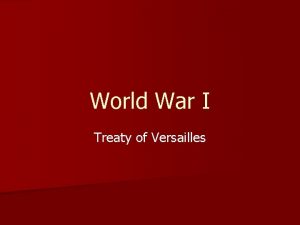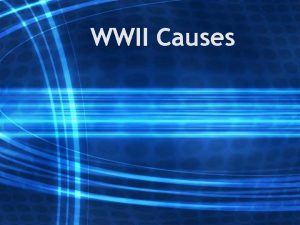The Treaty of Versailles A Costs of the


















- Slides: 18

The Treaty of Versailles A. Costs of the War B. What is the Treaty of Versailles? C. Who was there? D. The Results

CA Content Standard • 10. 6. 1 Analyze the aims and negotiating roles of world leaders, the terms and influence of the Treaty of Versailles and Woodrow Wilson's Fourteen Points, and the causes and effects of United States's rejection of the League of Nations on world politics.

Content and Language Objectives • Content Objective- Students will analyze the influence of the Treaty of Versailles. • Language Objective- Students will take notes, pair share, and answer questions about the lesson.

A. Costs of the War • 8. 5 million soldiers died, 21 million were wounded • 12 million civilians died because of the war – Starvation, disease, slaughter • Almost an entire generation of men were wiped out in France and Great Britain • Costs the Allied Powers $200 billion, and the Central Powers $138 billion – Acres of farmland, homes, villages, towns were all destroyed




CFU • What are three causes that civilians died during World War 1? Pair Share 30 Seconds (Pick non-volunteer)

B. What is the Treaty of Versailles? • It is the formal peace agreement that officially ended WWI • It was signed June 28, 1919 outside of Paris

CFU • What was the goal of the Treaty of Versailles? Pair Share 30 Seconds- (Pick nonvolunteer)

C. Who was there? • All of the Allied Powers (except Russia) were invited • “Big Four” were the main writers • They were the leaders of the U. S. , France, Great Britain, and Italy

• President Wilson (U. S. ) came to the meeting with a plan called the Fourteen Points to create a just and lasting peace -Wanted “a peace without victory” • France and Britain wanted revenge on Germany • Italy wanted to gain territory from the Central Powers

CFU • United States wanted _______. • France and Britain wanted _______. • Italy wanted _____. Pair Share 30 Seconds- (Pick a nonvolunteer)

D. The Results • Harsh peace for Germany which leads to WWII


• The United States refused to sign the treaty – did not want to join the League of Nations • Germany, Italy, and Japan will all resent the outcome


Closure- CFU • Describe the effects of the Treaty of Versailles. Pair Share 60 seconds Write down into notes (Pick non-volunteers)
 Treaty of versailles lamb
Treaty of versailles lamb Treaty of versailles terms
Treaty of versailles terms Treaty versailles terms
Treaty versailles terms Treaty of versailles the big three
Treaty of versailles the big three Treaty of versailles gargle
Treaty of versailles gargle Treaty of versailles gargle
Treaty of versailles gargle Trawl treaty of versailles
Trawl treaty of versailles 14 point plan vs treaty of versailles
14 point plan vs treaty of versailles Treaty of versailles 1815
Treaty of versailles 1815 Treaty of versailles terms
Treaty of versailles terms Conditions of the treaty of versailles
Conditions of the treaty of versailles The treaty of versailles
The treaty of versailles How did the versailles treaty help cause ww2
How did the versailles treaty help cause ww2 The big 4 and the treaty of versailles interactive notebook
The big 4 and the treaty of versailles interactive notebook Treaty of versailles guillotine cartoon analysis
Treaty of versailles guillotine cartoon analysis Treaty of versailles apush def
Treaty of versailles apush def B.r.a.t meaning treaty of versailles
B.r.a.t meaning treaty of versailles Map of europe
Map of europe The big 4 and the treaty of versailles
The big 4 and the treaty of versailles
